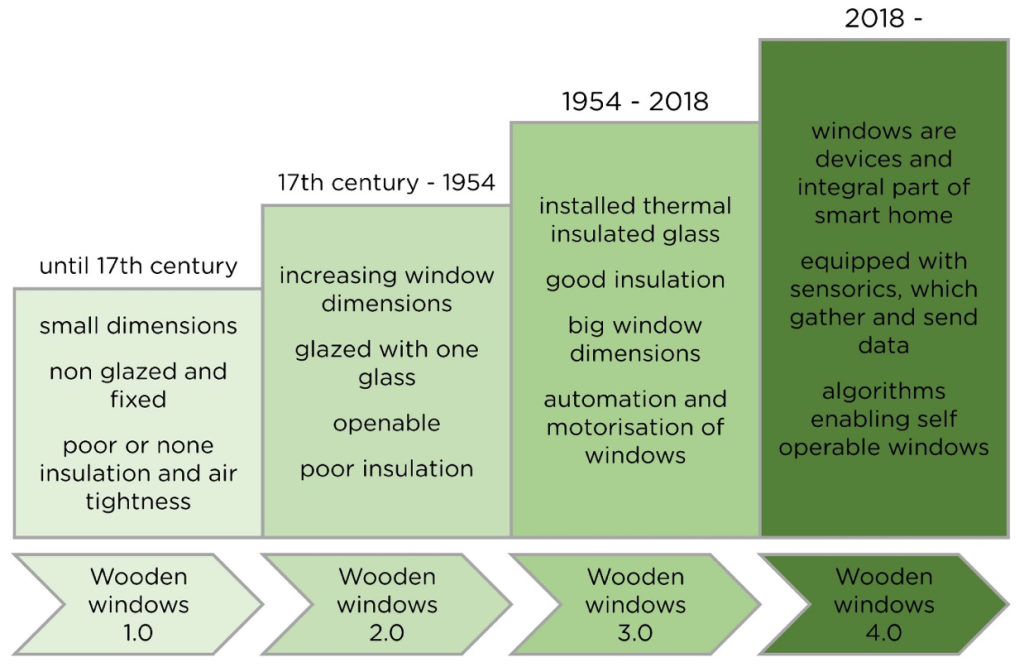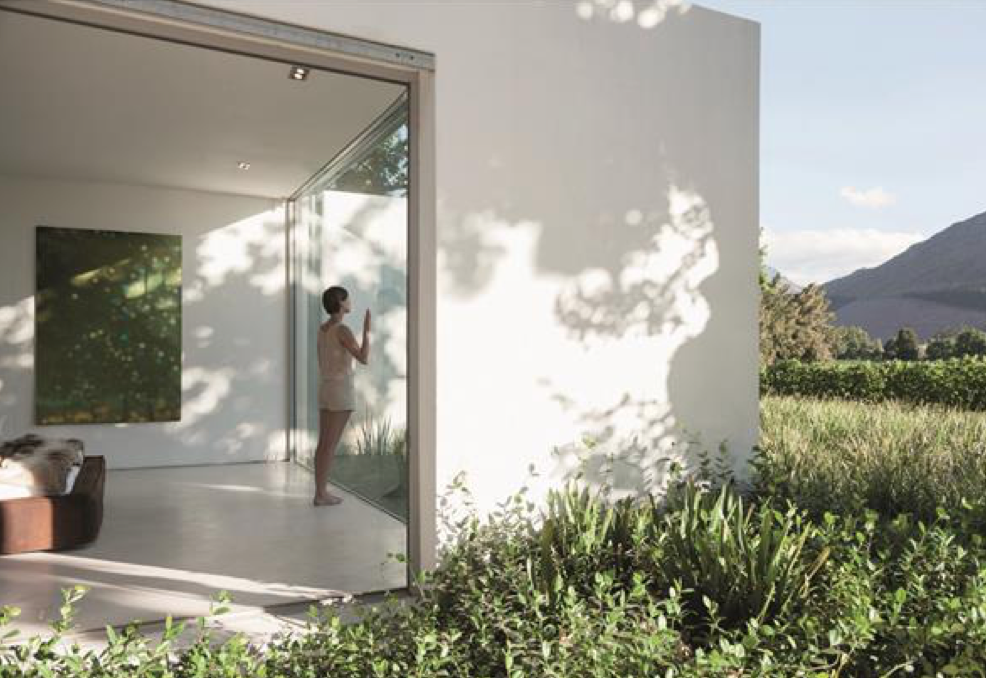Why 4.0?
Probably we associate the 4.0 most often with the term Industry 4.0. We are talking about the fourth industrial revolution with key features such as internet of things, cloud infrastructure and cloud solutions, big data, artificial intelligence, algorithms, blockchain, augmented reality, factories of the future… Wooden windows have not been “numerically” classified as industrial revolutions yet. According to their historical development, they can also be classified into four frames, whereby we are at the entrance to their fourth period.
From the very beginning, the wooden windows serve the key purpose – the transmission of the light into the interior. The history and development of wooden windows are related to the development of glass to a large extent. The initial period of the history of wooden windows (Wooden windows 1.0) dates back before the 16th century, when the windows were unglazed and fixed. The lines were either empty or covered with cloths, paper, wood, and even horn plates. The glass was extremely rare and reserved only for the wealthiest customers, although the beginning of the production of window glass (“broad sheet glass”) dates back to 1226 in the English city of Sussex. One of the oldest unglazed wooden windows can be found in the English village of Boxford, and its age is estimated to more than 1,000 years. The 16th century represents the first turning point in the development of windows, as they became ever larger, and the size of the window became the status symbol of the owner. The glazed windows were still rare but their use began to increase noticeably. In the 17th century, wooden windows began to be more and more popular. They were often glazed also in normal homes (Wooden Windows 2.0) as “crown glass” was presented in 1674. This has had a significant impact on the implementation of windows with sashes that were opening with parallel vertical or horizontal shifts (“sash window”), as is typical for Great Britain. The windows with opening casements around the axis as it is most often present today (“casement window”) were known already earlier. Until the 20th century, hand-blown glass was used, and large glasses were extremely expensive. The latter was the key reason that wooden windows contained a large number of small glass segments. In 1903, Michael Owens introduced a revolutionary solution in the form of automated machine manufacturing. The technology made possible to produce larger dimensions of flat glass at a lower price, which had a key effect on the appearance of the windows. Despite the fact that the technology made it possible to produce glass with a clearer and more homogeneous structure, it was still far from perfect. Sir Alastair Pilkington came close to this with an invention of the floating process for the production of flat glass in 1954. In these years, the first double pane insulating glass (Wooden Windows 3.0) appeared on the market, which idea originated from the early 1860s. The development was progressing at a high speed, and in the following decades the first coatings on glass (1960a), the first low-emission glasses (1980s), electrochromic glasses (1990a), thermochromic glasses (2000a) and thin photovoltaic films (2010a) were presented to market.

Today’s state-of-the-art of wooden windows offers highly insulated windows with three pane (in rare cases four pane) glazing and the best Uw (thermal transmittance of the window) values below 0.6 W/m2K, where insulating materials are integrated in wooden window profiles. Wood used in windows is mainly spruce, pine, larch, oak and certain tropical wood species. Insulated glass units are filled with inert gases (mainly argon and krypton), vacuum glasses, electrochromic glasses and glasses with touch screen function are available. Modern hardware allows motorized opening of windows or sliding doors, whereas elements are, in the vast majority of cases, up to 3 meters high due to static restrictions. The glass, hardware and the entire assembly of modern windows provide a high level of safety against impact and burglary. Wooden windows are appreciated and present an important aesthetic, security and insulation element of the modern buildings. Their purpose is primarily to ensure safety, isolation, light transmittance air ventilation.
We are entering into a new era of wooden windows – Wooden Windows 4.0, which development and integrated technologies are closely linked to Industry 4.0. Wooden windows will no longer be just an important part of the building envelope, but an active smart device that will be significantly more competent than currently state-of-the-art wooden windows. New materials will be introduced, their properties will be improved, and the used technologies will allow the wooden windows to become an integral device in the Internet of Things.
Wood, but which and in what shape?
The basic material of wooden windows is wood of high quality. Slovenia has currently an abundance of wood, although the recent natural diseases showed the vulnerability of Slovenian forests. Also in Europe, we are already facing the lack of quality wood, which, according to certain analyzes and forecasts, will even increase. As a consequence, the lack of wood will also affect its price and the price of new buildings, according to The Wall Street Journal. What kind of wood and in what form will we use it for the production of wooden windows in the coming decades? Will the most commonly used spruce be replaced by foreign tree species such as Douglas fir? Perhaps Paulownia which is considered as one of the fastest growing tree species in the world with quality and low weight wood? The latter can cause serious problems in Slovenian forests if ordinary Paulownia, which is considered as an invasive species is planted, instead of hybrid which is proper solution. Or will (r)evolution happen to the discarded timber, which is increasingly present in the manufacture of wooden products? The question does not offer a clear answer, but it depends primarily on our attitude towards the planet and the treatment of Slovenian forests.
Wooden windows over two floors?
The size of wooden windows is one of the key points of their modern development. Aluminium or steel windows that extend over two floors with a height of 5 meters or more are not unusual, but they are certainly impressive. The latter also applies to wooden windows with the crucial difference that wooden windows with a height of 5 meters are unusual. Their proper production, which will ensure the window to bear its own and external loads, is very complex and demanding due to the properties of the wood. Today’s wooden windows and sliding doors are usually made up to about 3 meters in height, whereas wooden windows with a height of 5 meters or more can be expected in the near future. This will be done by optimally positioning up reinforcements in key window elements, which will be supported by numerical analysis. This is being developed in the TIGR4smart and XtremelY projects.
What about insulation?
One of the most desirable targets for the manufacturers of wooden windows will always be to equalize the thermal transmittance of the window (Uw) with the thermal transmittance of the building wall (UBW). The current difference between the most insulated walls (UBW <0.1 W/m2K) and the most insulated wooden windows (Uw=0.5-0.6 W/m2K) is six times and more. This difference also depends on the size of windows, as the proportion of insulating glass increases with window size, which positively affects insulation. For the equalisation of UBW and Uw, it will be necessary to provide thermal transmission of glass (Ug) below 0.1 W/m2K. At the moment there are products with Ug=0.15 W/m2K, whereas experiments of glass with Ug=0.05 W/m2K can also be found. In both cases, the usability from the point of price, dimension and delivery is currently problematic. Regardless, it is realistic to expect that the insulation of the wooden windows will reach values of about 0.1 W/m2K, but the question is, at what stage of isolation the walls will be due to the development of super insulating and smart insulating materials.
Wooden windows as a part of Internet of Things.
Internet of Things (IoT) is a network of devices set up and presented on the internet. It represents a network in which devices either communicate with each other or with users. In 2010, Hans Vestberg, former director of Ericsson announced that 50 billion devices will be connected in 2020. The same announcement was made by Cisco in 2011, while IBM made an even more radical announcement with 1 trillion connected devices by 2015. It turned out that all of the forecasts were too optimistic, especially the one from IBM. Gartner company later estimated that there was only 6.4 billion connected devices in 2016, with a forecast of up to 20.8 billion by 2020. Both Ericsson and Cisco subsequently adjusted their forecasts. Regardless of the forecast and the actual situation it is a fact that IoT is not an issue of the future, but a realistic state of the present. This will only develop in the future at an unpredictable speed and the wooden windows won´t be missed. The basic condition for this is a window in such a form that will be suitable for integration into IoT. The way and form of the window that will be plugged into the entire system and connected to the internet will depend on the manufacturers, and in particular on the desire and needs of customers. However, the wooden window will undoubtedly have to ensure the autonomous operation and monitoring the key environmental and self parameters.
Step forward? Wooden windows, Internet of Things and Blockchain.
Both, IoT and blockchain represent revolutionary ideas and real technologies that take up a lot of dust, whereas their final implementation will still require many years of development. Each one of them represents breakthrough and partly disruptive technology, while the combination of both can lead to a revolution in the field of IoT of the future. Basically, IoT is a system of devices (in our case wooden windows) connected to the internet. These are, each in the concept of a smart home, connected to the central system. The latter represents the “brain” of the building and receives data from a single wooden window. Based on them it takes decisions if the system is properly programmed and works on the basis of selected algorithms. Blockchain is a computer system that enables the recording of cryptographically protected data that is untouchable, transparent and permanently written in the ledger. This ledger is not stored at one person or organization, but is distributed on a large number of computers around the world. The combination of these two technologies represents a verified, secure, and permanent solution for recording and using data from smart devices, thus solving the problematic issue of data manipulation and security. Encryption and distributed storage means trust in data and their security. The devices will safely record the details of the transactions of these data, which will take place without human presence. An example of a company that develops a decentralized system for interoperating devices in IoT and sharing their resources is IOTA, while IBM is also progressing on its Watson platform. In addition, instant payment of services will take an important role, which will be enabled by smart devices. A very simple example is the payment for the use of an electric vehicle that will be executed at the moment the user leaves the vehicle. For such payments, the technology of “smart contracts” will operate, which will enable a transparent, instant and fair payment for a particular service. And what role can a wooden window play in such a world? A wooden window will be an active device, an agent connected to the Internet. It will not only provide traditional features, but will provide for example, optimum ventilation, the acquisition and conversion of solar energy, the management of other devices via glass, online shopping … The wooden window will thus represent a device that will offer various services, thus opening up a new area for the development of non-traditional business models.
Wooden window as a product or as a service?
A wooden window 4.0 as a multifunctional agent will represent a unit, product, device, or service provider on a particular platform in the IoT world based on specific protocol. Which protocol will be is a question for a million dollars. This will certainly be clarified over the next 10 years. The principle is similar to the operation of world-famous platforms such as Uber and Airbnb, which link millions of cars or dwellings. In both cases, physical products are still in use, but they offer their services – transport and homestay. If the principle is transformed to the IoT area, we find ourselves on a huge platform of smart cities and communities. There are millions of connected smart devices, each offering a specific service. Wooden windows will be a part of them and their services will be defined during the development of the coming years, and will depend on the technology that will be built into a smart wooden window. Platforms that manage products are not the only option to offer windows or services. Sharing economy is increasingly being used in the world. Will the wooden windows be rented in the future? Basically, this can be a win-win situation for both the user and the producer of wooden windows. When renting a product, it is necessary to ensure the quality and functionality of the window in its entire lifetime, which is a direct advantage for the user. Both can be provided with regular services and real-time monitoring of window properties. This can be a direct benefit for the manufacturer of wooden windows, because the regular service is included either in the price of the product or is the annual cost for the user similar to the example of cars. Consequently, this also affects the increase in the added value of the wooden window and the company. In addition, with the constant monitoring of the properties of the window, we ensure the adequate quality of the basic materials that will be reused in the future for the production of new windows.
Wooden windows as a part of circular economy?
The prices of materials used in wooden windows are increasing and the same is expected in the future. The price of glass has increased by about 30 % since 2010, the price of zinc by more than 200 % since 2009 and the price of wood is also increasing. The rise in prices of key raw materials is particularly important for manufacturers of electronic devices, who are increasingly investing in the reuse of raw materials from waste products. We can expect similar in the field of wooden windows in the future. It will be crucial to ensure proper quality of materials for producers who will re-use materials and raw materials for new windows. The latter will be possible by constantly monitoring the windows. This will not only provide adequate quality, but will also allow predicting the lifetime of a wooden window. Here, artificial intelligence and machine learning will play an important role.
Wooden windows, artificial intelligence and machine learning
Bernard Marr nicely describes the difference between artificial intelligence (AI) and machine learning which are tightly correlated to Big Data. Artificial Intelligence is the broader concept of machines being able to carry out tasks in a way that we would consider “smart”. Machine Learning is a current application of AI based around the idea that we should really just be able to give machines access to data and let them learn for themselves. In both cases, it is essential to provide a sufficient amount of data that represents the “food” for intelligent operation. The data about the wooden window is provided by detecting the properties of the window itself and sensing its surroundings ambient conditions with the sensors. On the basis of these, a smart wooden window, through machine learning and artificial intelligence, will be able to recognize the habits of its user and consequently adjust and provide optimum conditions in the form of dimming of windows, opening windows for ventilation, projecting the forest on glass, etc. The idea is nothing new, as it happens similar to us every day from proposing books on Amazon, to the “random” choice of music on YouTube. With wooden windows, however, we may go a step further by predicting the lifetime of the window.
So what is the wooden window 4.0? It is the device of any size equipped with wireless sensors, which is an integral part of the Internet of things and, based on a large number of collected data, ensures smart operations adapted to a specific user in the widest possible sense.


